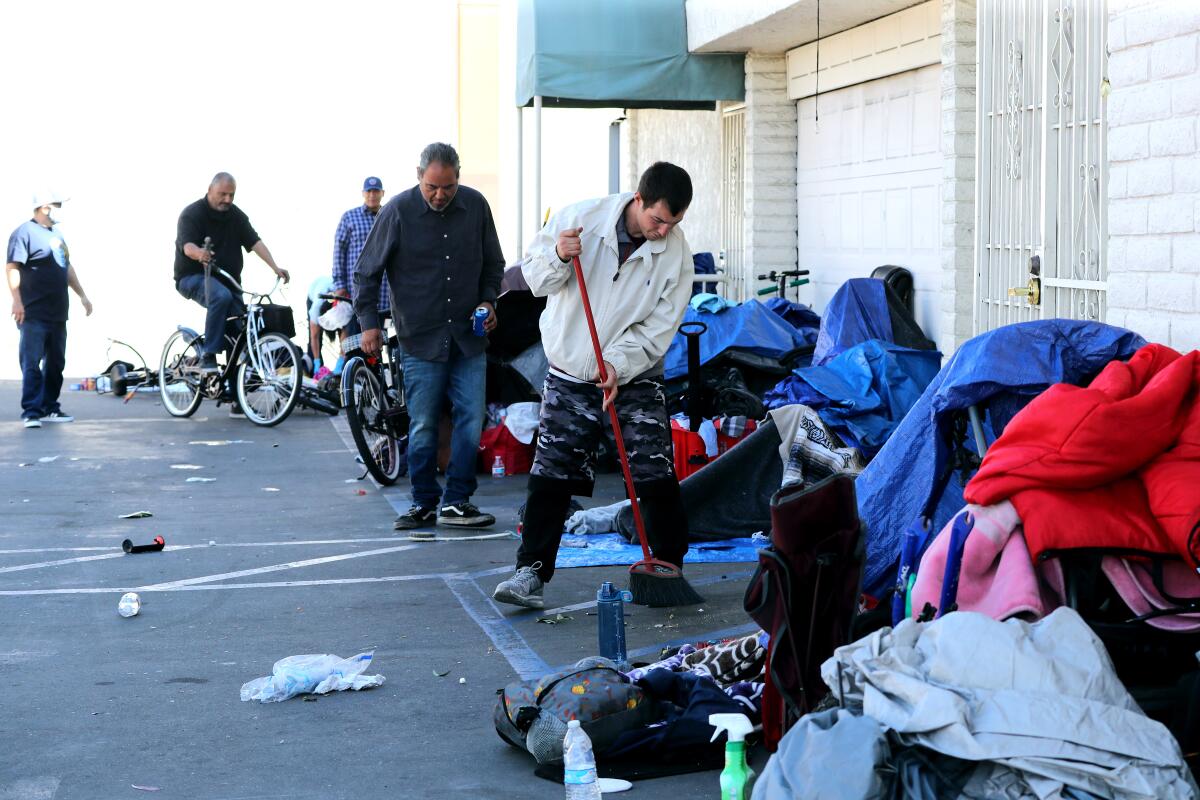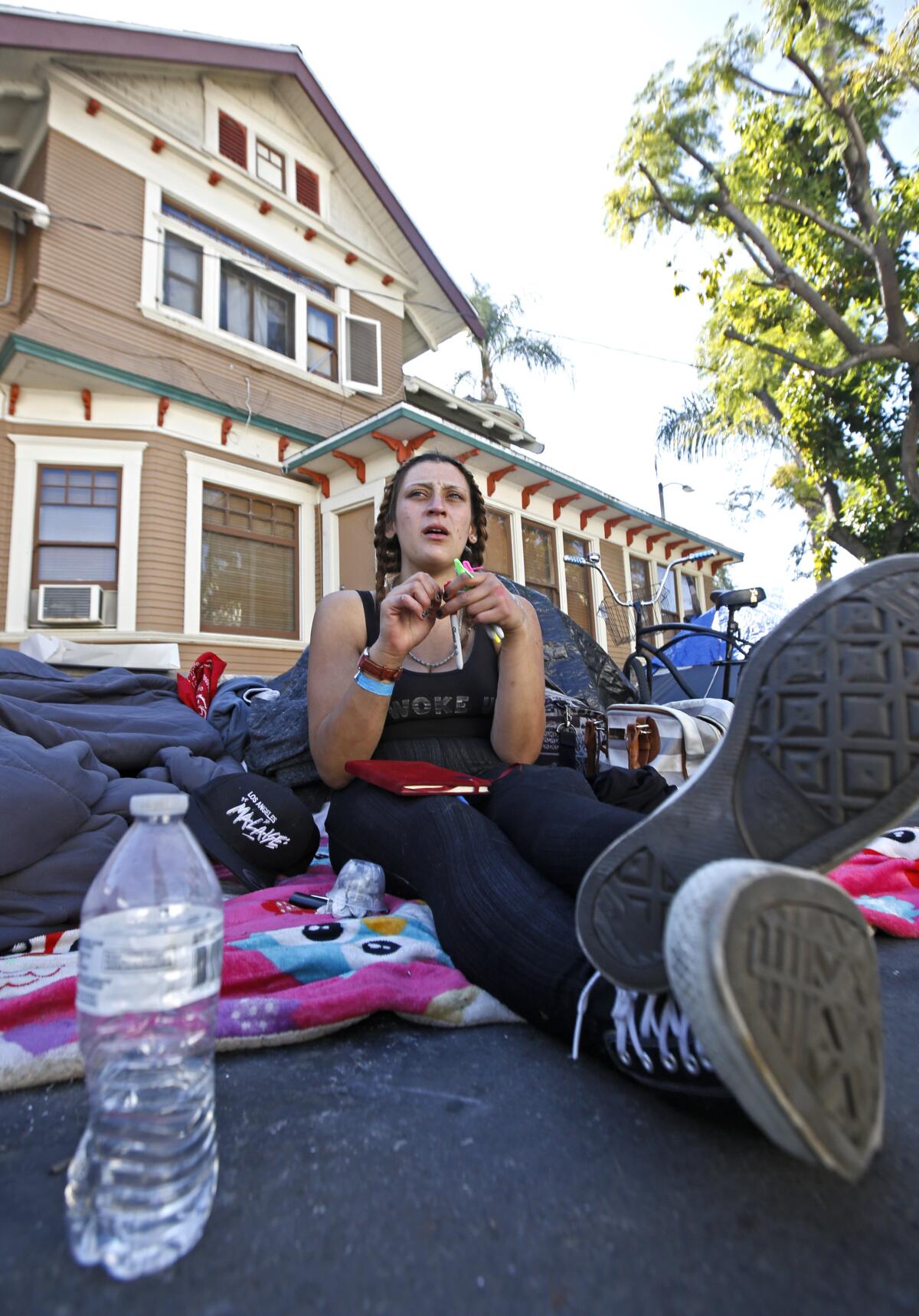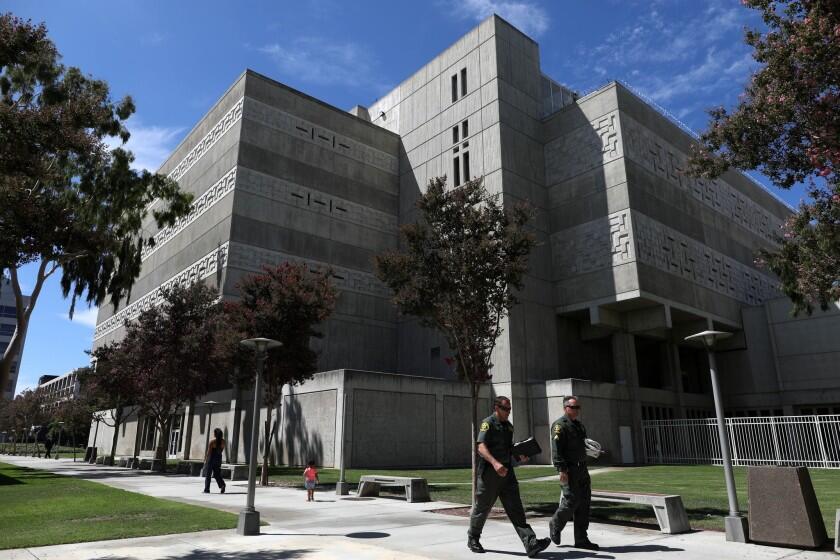Santa Ana could clear homeless encampment outside Mexican cultural center

- Share via
After clashing with the city of Santa Ana for months, a Mexican cultural center agreed in March to work with the city to clear a homeless encampment in its parking lots that has grown since the beginning of the pandemic.
That partnership has dissolved, and the city has attained an abatement warrant to clear the encampment.
Since the beginning of the pandemic, homeless people have been living in El Centro Cultural de México’s lots. The numbers steadily grew to an encampment of about 40 at any given time.
El Centro, which is a linchpin for the local Latino community, faced pressure from the city for months to clear the encampment, including being fined about $1,800 for not keeping the area clean. But El Centro continued to allow homeless people to live in the lots despite pressure from the city, contending that individuals without housing should not be criminalized.
The center and city came to an agreement in mid-March after the city sent El Centro a proposed plan to clear out the homeless encampment within 45 days. The city agreed to work with El Centro to connect homeless people with services and waive the fines. Ben Vazquez, a longtime volunteer and board member with El Centro, said at the time that the cultural center largely agreed to the terms because of the city’s threat of the abatement warrant.
The 45-day deadline ended on Friday, April 30.
Vazquez said this week that there were still about 20 homeless people living in the parking lots. He said El Centro sent a request for an extension to the city.
Santa Ana city spokesman Paul Eakins said the city has not granted the extension request and considers El Centro to be in breach of the agreement. On Tuesday, the city obtained an abatement warrant to clear the property.
“No extension has been granted, and we consider El Centro to be in breach of the settlement agreement,” Eakins said.
It’s unclear what the clearing of the encampment could look like, and Eakins would not discuss when or how the city would serve the warrant.

Eakins said that the majority of the homeless people at the encampment declined offers for shelter, but El Centro contends that the city hasn’t had available shelter beds for those they are trying to connect with services.
Vazquez said the city closed one of its homeless shelters, the Link, making it more difficult for El Centro to connect the homeless with services. El Centro has been working with various nonprofits, including Wound Walk and Brooke Weitzman of the Elder Law and Disability Rights Center in Santa Ana.
“They really gave us no place to place people,” Vazquez said of the city.
Vazquez said he hoped that the city would grant the extension and reopen the Link so the homeless staying at the encampment could have access to those beds.
The Orange County Sheriff’s Department said it has resumed serving hot meals in county jails, more than a week after a state board sent a letter to the department informing them that they were violating state jail regulations.
Eakins said the Link closed last week because it was considered to be a temporary shelter and is supposed to be replaced by the city’s Carnegie Avenue shelter, which hasn’t yet opened. The homeless people who were housed at the Link were relocated to the Illumination Foundation’s shelter in Fullerton.
Eakins said the only physical homeless shelter in the city right now is the Yale shelter, but there are beds available for Santa Ana residents at the Fullerton shelter.
Paul Leon, chief executive of Illumination Foundation, said all 51 people who were at the Link were transferred to the Fullerton shelter, which has a capacity of 150. He said there are about 45 more beds open for Santa Ana homeless people.
“People wanting help in Santa Ana is not the same as agreeing to be shipped from city to city like property any time their mere existence is inconvenient,” said Weitzman, who represents homeless people.
The closure of the Link came just a few months after the county shut down its only walk-in homeless shelter, the Courtyard, in downtown Santa Ana. Weitzman said the Courtyard was supposed to be replaced by the county’s new Yale shelter, but due to COVID-19 distancing guidelines, the new shelter has fewer available beds.
Weitzman said many of the homeless people at the encampment were hoping to be admitted to the Yale shelter or the Link.
“The only walk-in shelter closed, the only place you could walk up to the front door and say I need help today,” Weitzman said. “There is no longer a shelter in Orange County where, if you don’t have a phone or a caseworker, you can walk in. Now you have to go find a police officer or case worker and convince them to give you a referral for a shelter bed. So the limit on access went away when that last walk-in shelter closed.”

Eakins said the city, as part of the agreement, provided four portable restrooms, a wash station and two outreach events to El Centro to connect the homeless with services. Eakins said about 17 people were brought to a shelter after the outreach events. Vazquez said El Centro didn’t keep count of how many people it connected with services.
During the outreach events, the city partnered with several health and social service organizations to provide COVID-19 testing and vaccines, social services, medical care, legal assistance and other aid, Eakins said.
“The City of Santa Ana has worked closely with El Centro Cultural de Mexico to find a compassionate solution to address the unpermitted homeless encampment at the organization’s property that has negatively impacted the surrounding neighborhood and become a public health and safety concern,” Eakins said.
In a Voice of OC opinion article posted Tuesday, Councilman Phil Bacerra said El Centro has hurt the community by not attempting to partner with the city sooner to get homeless people connected to services.
He specifically called attention to residents of the nearby Willard neighborhood who have been contacting the city with complaints about the conditions of the homeless encampment.
“The current conditions at El Centro’s site, such as open defecation and used drug needles scattered about, are creating a danger to public health for the families and children of the surrounding Willard neighborhood as well as the Civic Center employees who use the parking structure across the alley from the El Centro site,” Bacerra wrote.
“What El Centro has done on their site to the schools and residents of the Willard neighborhood should never be tolerated on any private property in Santa Ana. El Centro should stick to their stated mission of promoting an understanding and awareness of the Mexican culture, because by allowing the homeless encampment to continue to exist on their site, El Centro continues to fail the community.”
At a Santa Ana City Council meeting on Tuesday night, council members and supporters of El Centro voiced their opinions on the encampment issue.
Several people spoke out in favor of El Centro and a few took aim at Bacerra’s opinion piece.
Hairo Cortes, executive director of Chispa — an immigrant rights organization in Santa Ana, said he hoped that the city would continue to work with El Centro. He also addressed Bacerra’s post.
“It was a very foolish Op-Ed,” Cortes said.
Resident Tim Rush was critical of El Centro.
“It is astonishing to me that these folks who are calling in and wanting to advocate for El Centro never for a moment stop to make any accommodation for the folks who live in that neighborhood,” Rush said, adding that he regularly sees the “mess” outside El Centro.

At the request of Councilman Johnathan Hernandez, the council discussed whether the city could look into utilizing Project Roomkey to help with the El Centro encampment.
Project Roomkey is a statewide program started during the pandemic that places homeless Californians in hotel rooms. The program, which was used by Orange County, was called overly restrictive by some local homeless advocates.
City Manager Kristine Ridge said at the meeting that the city can use Project Roomkey if it comes across an individual who qualifies for the program.
“I know some of us are on the opposite sides of the spectrum when it comes to this particular encampment, but if there’s one thing that we can all come to terms with, it’s that nobody by any circumstance should be living on the street,” Hernandez said. “It’s a very harsh reality, and I want to see these folks get the supportive services that they deserve, rather than just going in and clearing out this encampment.”
All the latest on Orange County from Orange County.
Get our free TimesOC newsletter.
You may occasionally receive promotional content from the Daily Pilot.







